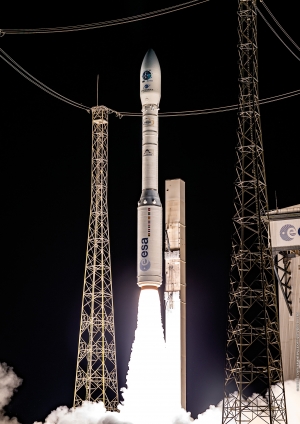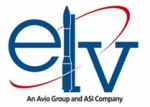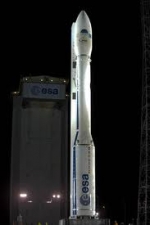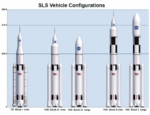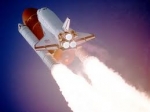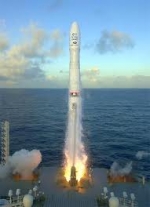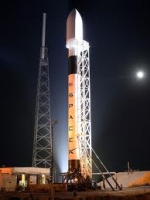Displaying items by tag: launcher
Vega - rocket
Vega (Vettore Europeo di Generazione Avanzata - European Advanced Generation Carrier) is an expendable launch system developed for Arianespace jointly by the Italian Space Agency (ASI) and the European Space Agency (ESA). Italy is the leading contributor to the Vega program of ESA; other participants include France, Belgium, Spain, The Netherlands, Switzerland and Sweden. 1) 2) 3) 4)
The program began in 1998, it is managed jointly by an IPT (Integrated Project Team) composed of staff from ESA, ASI and CNES. The industrial consortium for the construction of the launcher is lead by the prime contractor ELV S.p.A. of Italy.
European Launch Vehicle (ELV)
European Launch Vehicle (ELV) is an Italian company established by Avio and ASI (Italian Space Agency) in December 2000.
It was selected by ESA, the European Space Agency, to serve as prime contractor in the activities geared to the development of the European launcher, called Vega, and other small launchers with all associated technologies. The company is responsible for every aspect of system development, from the drafting of the specifications, through production, to its integration in the launch pad. Elv's primary tasks include managing and planning launcher design, development, qualification and production processes, by coordinating the activities of the subcontracts participating in the programme. Moreover, ELV coordinates and ensures the integration of the launcher in the lift-off facilities and participates with a team in the final stage of the launch.
At present (Nov. 2013) ELV is owned 70% by Avio SpA and 30% by ASI. Headquartered in Rome, it has an operational facility in Colleferro (Rome, Italy), where Avio has its main aerospace operations: one of the most dynamically innovative production centres, at the forefront of science and technology.
XPOD Separation System
The XPOD Separation System was developed through the SFL CanX Nanosatellite Program.
The XPOD is an enclosed "jack-in-the-box" container for separating nanosatellites from virtually any launch vehicle. Various models are available, including models compatible with the CalPoly CubeSat standard. Once a deployment signal is received from the launch vehicle, a power supply inside the XPOD activates a release mechanism causing a door to open and the spacecraft to be ejected. The XPOD implements a single-failure fail-operational design, and is customizable for spacecraft up to 14kg with arbitrary dimensions. Also available are semi-enclosed (or "open concept") designs that accommodate fixed appendages. Recently, six XPODs flew successfully aboard PSLV-C9 including the XPOD Single, XPOD Triple, and XPOD GNB models (pictured above).
Fregat rocket upper stage
Fregat is a type of rocket stage developed by NPO Lavochkin in the 1990s.
The main part of the stage is six intersecting spheres placed on a single plane, four of which contain propellants. The remaining two contain the control equipment. The main engine is placed between the spheres, so Fregat is a tightly-packed stage with a diameter much larger than its height. Fregat is a versatile spacecraft. For example, in addition to orbital insertion, it can be used as an escape stage to launch modern space probes into interplanetary trajectories (e.g., Venus Express and Mars Express).
Fregat stages are currently (June 2013) used as the fourth stage of some Soyuz-FG launch vehicles. A version called Fregat-SB can be used with Zenit-2SB rocket. This version has a block of drop-off tanks which makes increased payload capability possible. Fregat-SB was launched for the first time on 20 January 2011, when it lifted the Elektro-L weather satellite into geosynchronous orbit.
The stage can be restarted multiple times, which has been used to place payloads such as the GIOVE-B satellite into their planned orbits.
Its main engine is a liquid propellant rocket that uses UDMH and N2O4 as propellants.
Vega launcher
Vega is an expendable launch system in use by Arianespace jointly developed by the Italian Space Agency and the European Space Agency (ESA).
Development began in 1998 and the first launch took place from the Guiana Space Centre on 13 February 2012.
It is designed to launch small payloads — 300 to 2,500 kg satellites for scientific and Earth observation missions to polar and low Earth orbits. The reference Vega mission is a polar orbit bringing a spacecraft of 1,500 kilograms to an altitude of 700 kilometers.
Vega is a single-body launcher with three solid rocket stages, the P80 first stage, the Zefiro 23 second stage, the Zefiro 9 third stage, and a liquid rocket upper module called AVUM.
Dnepr rocket
The Dnepr rocket is a space launch vehicle named after the Dnieper River.
It is a converted ICBM used for launching artificial satellites into orbit, operated by the launch service provider ISC Kosmotras. The first launch, on April 21, 1999, successfully placed UoSAT-12, a 350 kg demonstration mini-satellite, into a 650 km circular Low Earth orbit.
The Dnepr is based on the R-36MUTTH ICBM – called the SS-18 Satan by NATO.
Space Launch System (SLS)
The Space Launch System, or SLS, is a Space Shuttle-derived heavy launch vehicle being designed by NASA.
It follows the cancellation of the Constellation Program, and is to replace the retired Space Shuttle.
Space Shuttle
The Space Shuttle was a partially reusable launch system and orbital spacecraft operated by the NASA for human spaceflight missions.
The system combined rocket launch, orbital spacecraft, and re-entry spaceplane with modular add-ons. The first of four orbital test flights occurred in 1981 leading to operational flights beginning in 1982. It was used on a total of 135 missions from 1981 to 2011 all launched from the Kennedy Space Center, Florida.
The Space Shuttle at launch consisted of the Orbiter Vehicle (OV), one external tank (ET), and two Solid Rocket Boosters (SRBs). The orbiter decelerated in the atmosphere before flying like a glider but with reaction control system thrusters before landing on a long runway.
The final Space Shuttle mission was in July 2011 to deliver parts to the International Space Station (ISS).
Zenit (rocket family)
Zenit is a family of space launch vehicles designed by the Yuzhnoye Design Bureau of Ukraine.
Zenit was built in the 1980s for two purposes: as a liquid rocket booster for the Energia rocket and, equipped with a second stage, as a stand-alone rocket. Moreover Zenit was planned to take over manned spaceship launches from Soyuz, but these plans were abandoned after the fall of the Soviet Union.
Zenit-3SL is launched by the Sea Launch consortium's floating launch platform in the Pacific Ocean and Zenit-2 is launched from Baikonur Cosmodrome in Kazakhstan.
Falcon 9
Falcon 9 is a rocket-powered spaceflight launch system designed and manufactured by SpaceX, headquartered in Hawthorne, California. Both stages of its two-stage-to-orbit vehicle use liquid oxygen (LOX) and rocket-grade kerosene (RP-1) propellants. The Falcon 9 can lift payloads of 13,150 kilograms to low Earth orbit, and 4,850 kilograms to geostationary transfer orbit, which places the Falcon 9 design in the medium-lift range of launch systems.
The Falcon 9 and Dragon combination won a Commercial Resupply Services (CRS) contract from NASA to resupply the International Space Station under the Commercial Orbital Transportation Services (COTS) program. The first commercial resupply mission to the International Space Station launched on October 7, 2012.


